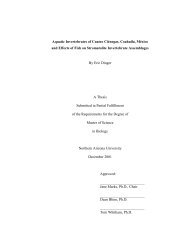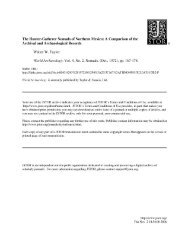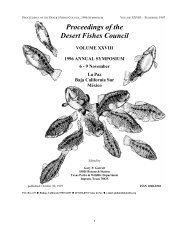Proceedings of the Desert Fishes Council 2000
Proceedings of the Desert Fishes Council 2000
Proceedings of the Desert Fishes Council 2000
Create successful ePaper yourself
Turn your PDF publications into a flip-book with our unique Google optimized e-Paper software.
PROCEEDINGS OF THE DESERT FISHES COUNCIL - VOLUME XXX1I (<strong>2000</strong> SYMPOSIUM) – PUBLISHED NOVEMBER 13, 2001<br />
Mateos, M 1 ; Sanjur, OI 2 ; Vrijenhoek, RC 1<br />
(1-Monterey Bay Aquarium Research Institute; 2-NAOS Marine Lab, Smithsonian Tropical Research Institute, Panama)<br />
Genealogical relationships among species <strong>of</strong> <strong>the</strong> genus Poeciliopsis<br />
ABSTRACT<br />
We examined mitochondrial cytochrome b gene sequences to assess phylogenetic relationships among 12 <strong>of</strong><br />
20 extant species in <strong>the</strong> genus Poeciliopsis (Cyprinodontiformes: Poeciliidae). Although relationships among<br />
several morphologically similar species had been hypo<strong>the</strong>sized, this is <strong>the</strong> first attempt to infer phylogenetic<br />
relationships among members <strong>of</strong> <strong>the</strong> genus. Monophyly <strong>of</strong> <strong>the</strong> subgenus Poeciliopsis was strongly supported, as<br />
well as monophyly <strong>of</strong> <strong>the</strong> subgenus Aulophallus (represented by Poeciliopsis elongata and P. retropinna).<br />
However, monophyly <strong>of</strong> <strong>the</strong> genus was not supported. Thus, <strong>the</strong> genus Poeciliopsis as presently constructed may<br />
comprise an artificial grouping. Earlier proposals regarding relationships among several closely related species<br />
in <strong>the</strong> subgenus Poeciliopsis were confirmed for <strong>the</strong> most part and grouped <strong>the</strong> 11 species into four 4 main<br />
clades. However, <strong>the</strong> relationships among <strong>the</strong>se clades could not be resolved. Fur<strong>the</strong>rmore, <strong>the</strong> Leptorhaphis<br />
superspecies group (Poeciliopsis infans, Poeciliopsis lucida, and Poeciliopsis occidentalis) was also found to<br />
contain Poeciliopsis prolifica. Possible causes for <strong>the</strong> low resolution <strong>of</strong> <strong>the</strong>se analyses are mutational saturation<br />
(especially in relation to <strong>the</strong> outgroup taxa) and lineage sorting. Additional taxa and characters (o<strong>the</strong>r genes) are<br />
needed to fully resolve <strong>the</strong>se relationships.<br />
RESUMEN<br />
Relaciones genealógicas entre especies del género Poeciliopsis<br />
Analizamos secuencias de citocromo b mitocondrial con el fin de investigar las relaciones filogenéticas<br />
entre 12 de 20 especies existentes del género Poeciliopsis (Cyprinodontiformes: Poeciliidae). Aunque ya se<br />
habían propuesto relaciones filogenéticas entre varias especies morfológicamente similares del género, este<br />
constituye el primer intento por comprobar tal hipótesis. Los resultados apuntan fuertemente hacia una<br />
mon<strong>of</strong>ilia del subgénero Poeciliopsis asi como el subgénero Aulophallus (representado por Poeciliopsis<br />
elongata y P. retropinna), sin embargo, la mon<strong>of</strong>ilia del género no fue verificado. Por lo tanto, el género<br />
Poeciliopsis pudiera ser considerado como una agrupación artificial en su forma actual. Se confirmó que<br />
anteriores suposiciones sobre las relaciones entre varias especies cercanas del subgénero Poeciliopsis eran<br />
ciertas en su mayoría, y las 11 especies fueron agrupadas en cuatro clades principales. No obstante, no fue<br />
posible dirimir las relaciones entre tales clades. Más aún, se encontró que el grupo superespecífico<br />
Leptorhaphis (Poeciliopsis infans, P. lucida y P. occidentalis) incluye también a Poeciliopsis prolifica. Las<br />
causas posibles de la baja resolución de estos análisis son la saturación de mutaciones (en particular en relación<br />
a los taxa externos [“outgroups”]), y separación de linajes [“lineage sorting”]. Para resolver estas relaciones por<br />
completo se requieren taxa adicionales además de otros caracteres (otros genes).<br />
Simms, JR<br />
(US Bureau <strong>of</strong> Land Management)<br />
Cienega Creek stream restoration project<br />
ABSTRACT<br />
A 1.4-mile reach <strong>of</strong> Cienega Creek, Pima County, Arizona, was disturbed by farming activities in <strong>the</strong> 1970s.<br />
Modifications included three dams, one levee and a road crossing/canal system that diverts water away from<br />
three miles <strong>of</strong> <strong>the</strong> creek into a small tributary. This disturbance has affected riparian vegetation development<br />
and habitat for a multitude <strong>of</strong> special-status species, including Poeciliopsis occidentalis (Gila topminnow), Gila<br />
intermedia (Gila chub), Empidonax traillii (southwestern willow flycatcher), Thamnophis eques (Mexican garter<br />
snake) and Rana chiricahuensis (Chiricahua leopard frog). The hydrologic and ecologic processes <strong>of</strong> this stream<br />
segment were restored using principles <strong>of</strong> stable natural channel morphology with <strong>the</strong> idea that restoration<br />
would be self-sustaining under <strong>the</strong> current sediment load and hydrography. Key aspects <strong>of</strong> <strong>the</strong> design were to<br />
maintain <strong>the</strong> proper pattern, dimension and pr<strong>of</strong>ile <strong>of</strong> <strong>the</strong> segment being restored. Structures were removed, <strong>the</strong><br />
diversion canal blocked, road crossing moved and reconstructed, and a new stream segment constructed.<br />
13



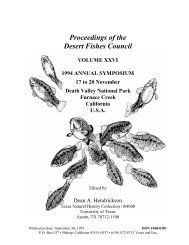
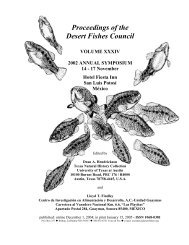
![Part 2 [419KK] - Desert Fishes Council](https://img.yumpu.com/14712282/1/190x245/part-2-419kk-desert-fishes-council.jpg?quality=85)

